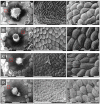Essential Oils and Hydrolates: Potential Tools for Defense against Bacterial Plant Pathogens
- PMID: 35456755
- PMCID: PMC9031397
- DOI: 10.3390/microorganisms10040702
Essential Oils and Hydrolates: Potential Tools for Defense against Bacterial Plant Pathogens
Abstract
The essential oils (EOs) of Origanum compactum and Satureja montana chemotyped (CT) at carvacrol, two Thymus vulgaris CT at thujanol and thymol, and Hydrolates (Hys) of S. montana and Citrus aurantium var. amara were chosen for studying their bactericidal efficacy against few phytobacterial pathogens. The Minimal Inhibitory Concentration (MIC) and Bactericidal Concentration (MBC) were found by microdilution assay. The essential oils of O. compactum (MBC 0.06% v/v), T. vulgaris CT thymol (MBC 0.06% v/v), and Hy of C. aurantium (MBC 6.25% v/v) resulted in being the most effective against Erwinia amylovora; thus, they were used as starting concentrations for ex vivo assays. Despite the great in vitro effectiveness, the disease incidence and the population dynamic ex vivo assays showed no significant results. On the other hand, EO of O. compactum and Hy of C. aurantium (at 0.03% and 4.5% v/v, respectively) showed resistance induction in tomato plants against Xanthomonas vesicatoria infections; both treatments resulted in approximately 50% protection. In conclusion, EOs and Hys could be promising tools for agricultural defense, but further studies will be necessary to stabilize the EOs emulsions, while Hys application could be an effective method to prevent bacterial diseases when used as resistance inducer by pre-transplantation treatment at roots.
Keywords: antibacterial activity; essential oil; hydrolate; induced resistance; sustainable agriculture defence.
Conflict of interest statement
The authors declare no conflict of interest.
Figures










References
-
- Labadie C., Ginies C., Guinebretiere M.H., Renard C.M.G.C., Cerutti C., Carlin F. Hydrosols of Orange Blossom (Citrus aurantium), and Rose Flower (Rosa damascena and Rosa centifolia) Support the Growth of a Heterogeneous Spoilage Microbiota. Food Res. Int. 2015;76:576–586. doi: 10.1016/j.foodres.2015.07.014. - DOI - PubMed
-
- Di Vito M., Bellardi M.G., Mondello F., Modesto M., Michelozzi M., Bugli F., Sanguinetti M., Sclocchi M.C., Sebastiani M.L., Biffi S., et al. Monarda Citriodora Hydrolate vs Essential Oil Comparison in Several Anti-Microbial Applications. Ind. Crops Prod. 2019;128:206–212. doi: 10.1016/j.indcrop.2018.11.007. - DOI
-
- Sharifi-Rad J., Sureda A., Tenore G.C., Daglia M., Sharifi-Rad M., Valussi M., Tundis R., Sharifi-Rad M., Loizzo M.R., Oluwaseun Ademiluyi A., et al. Biological Activities of Essential Oils: From Plant Chemoecology to Traditional Healing Systems. Molecules. 2017;22:70. doi: 10.3390/molecules22010070. - DOI - PMC - PubMed
LinkOut - more resources
Full Text Sources

